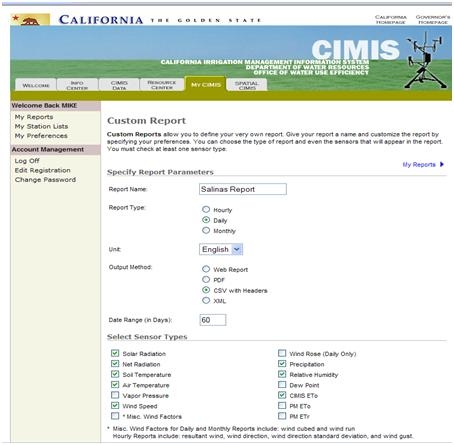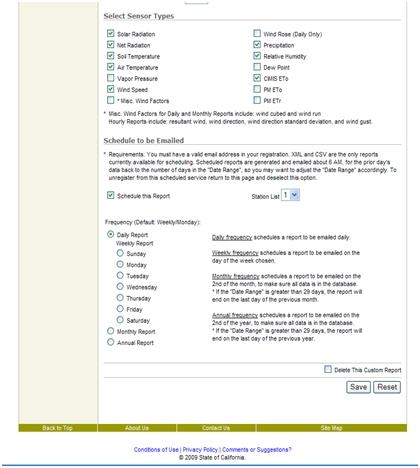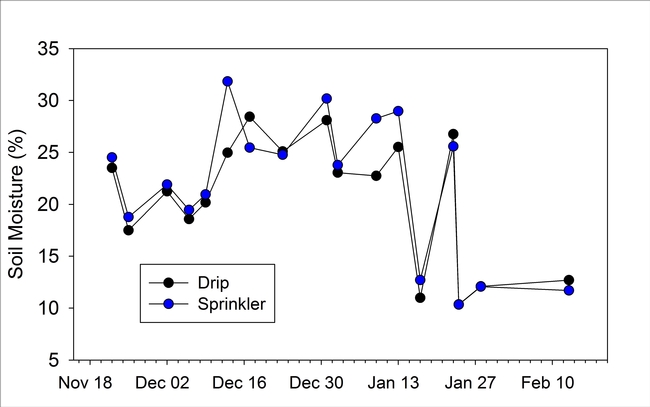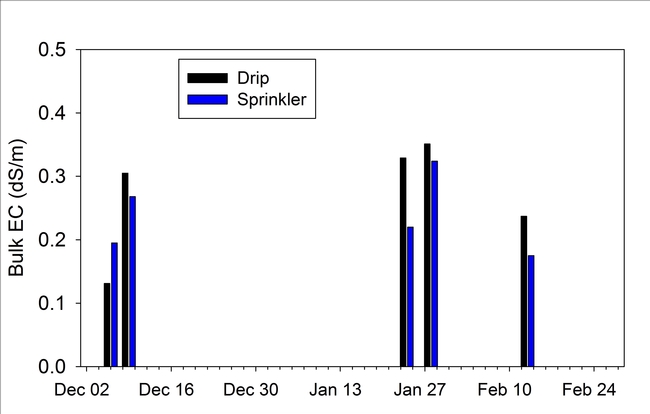- Author: Michael D Cahn
If you missed the 2015 Irrigation and Nutrient Meeting or you would like to review the presentations, you can download pdf versions of the powerpoint files from the UCCE Monterey County Website (http://cemonterey.ucanr.edu). The direct link to the presentations is:
http://cemonterey.ucanr.edu/Vegetable_Crops/2015_Irrigation_-_Nutrient_Management_Meeting_
We want to thank all of you who attended for your participation and for the many constructive comments that we received verbally and through the evaluation surveys. Let us know of any topics that you would like us to address in the next irrigation and nutrient management meeting or ways to improve the meeting.
If you are interested to learn more about CropManage for improving irrigation and nutrient management, I plan to host a hands-on training on using this on-line decision support tool on April 2nd. I will send out a formal announcement in the upcoming weeks.
- Author: Michael D Cahn
- Author: Oleg Daugovish
- Author: Mark Bolda
Establishing strawberry transplants using drip has several potential advantages compared to overhead sprinklers. Irrigation run-off can be greatly reduced, which protects surface water quality. Some growers have found that they can save water using drip for transplant establishment, and save costs associated with using overhead sprinklers. Often nitrogen fertilizer can be spoon fed to the crop through the drip system earlier in the season than in fields established with sprinklers, thereby reducing the reliance on pre-plant fertilizers that may result in nitrate leaching losses.
Nevertheless, growers are concerned that irrigating transplants using mainly drip may result in less vigorous growth and more dead plants during the establishment period, and yields during the production season will be lower than crops established with sprinklers. One of the specific concerns is that the drip lines adjacent to plant rows may not be as effective in leaching salts from the root zone of young plants as overhead sprinklers. Another worry is that if the transplants are not properly planted and gaps exist between the root crown and the soil, moisture will not move toward and imbibe young roots, and the plant may be set back or die.
Last year was challenging for establishing strawberries is many fields on the Central Coast due to the lack of rain, which normally helps to leach salts that may accumulate around young strawberry transplants. However, these challenging conditions were perfect for comparing vigor and yield of strawberries established using drip and overhead sprinklers.
Field trial description
We conducted a demonstration trial at a ranch in North Salinas beginning November 13, 2013. Soil was a loam texture. The field was planted with UC Albion variety in 2 rows on 52-inch wide beds. Two plots, each of approximately 1-acre in size, were located adjacent to each other in one of the irrigation blocks. Transplants were established using drip in one of the plots and with overhead sprinklers in the other plot. The irrigation foreman made all decisions on how long and often to irrigate both plots. Overhead sprinklers were used for the first 2 irrigations in the drip plot to assure that the transplants were in good contact with the soil. All subsequent irrigations were made using 2 lines of drip tape per bed. In the plot established with overhead sprinklers, transplants were also irrigated twice using the drip system. The last sprinkler irrigation was on January 25th, after which both plots were irrigated with only drip.
Applied water was monitored using flow meters installed on the drip submain and on the sprinkler main line until the end of February. Soil moisture was evaluated in the upper 6 inches of soil next to the transplants using a volumetric moisture sensor at weekly intervals during establishment. Soil salinity was also periodically monitored to a 4 inch depth next to the transplants using a soil salinity sensor (Fig 1.), or by sampling soil and analyzing saturated paste extracts for salts. Plants were rated for vigor and evaluated for canopy cover until mid February (Fig 2.). Marketable fruit yield was evaluated between late April and mid July.
Figure 1. A 5TE decagon probe was used to measure bulk salinity near strawberry plants.
Figure 2. Transplants were periodically evaluated for canopy size by measuring plant width or using a multi-spectral NDVI camera.
Results
Applied water during transplant establishment was about 25% less for the drip treatment compared to the standard sprinkler treatment. As shown in Fig. 3, irrigation water applied to the drip treatment equaled 6.8 inches between Nov. 13 and Feb. 20th. During the same period, water applied in the sprinkler treatment equaled 9.1 inches. An additional 1.5 inches of rainfall were also measured during this period. Estimated evapotranspiration (ET) losses during establishment were 3.2 and 1.1 inches for the sprinkler and drip treatments, respectively. The lower estimated ET amount for drip was due to less wetting of the furrows than in the sprinkler treatment.
Figure 3. Irrigation water and rainfall for the drip and sprinkler treatments between Nov. 13 and Feb. 20th.
Soil moisture measured near the transplants was similar among the drip and sprinkler establishment treatments except for 4 dates between mid December and mid January when the sprinkler plot had higher soil moisture levels than the drip plot (Fig 4).
Figure 4. Volumetric soil moisture measured next to transplants for the drip and sprinkler treatments.
Bulk electrical conductivity (EC), an indirect measure of soil salinity, was slightly higher next to the drip established transplants than the sprinkler established transplants for 4 of 5 dates measured between December and early February (Fig. 4). Bulk EC values were generally low for both treatments, which was confirmed from the saturated paste extracts of soil sampled on January 24 2014 (3rd evaluation date). The EC of the saturated paste extract was 0.80 and 1.83 dS/m, respectively, for the sprinkler and drip established plots. Saturated pasted extract values below 2 dS/m would not be expected to harm strawberry plant growth. Plant vigor (Fig. 5) and canopy cover (Fig. 6) were not different between the sprinkler and drip establishment treatments. Likewise cumulative fruit yields (Fig. 7) were the same for the two methods of irrigation establishment.
Figure 5. Bulk electrical conductivity of the soil adjacent to strawberry transplants, measured using the Decagon 5TE probe.
Figure 6. Plant vigor of drip and sprinkler established transplants, where 0 equates to dead or dying plants, and 5 signifies all plants are very healthy.
Figure 7. Percentage of ground shaded by leaves, measured using a multi-spectral infra-red camera.
Figure 8. Cumulative marketable fruit yield for sprinkler and drip established plants.
Discussion and Conclusions
The results of this field trial demonstrated that drip can be successfully used to establish strawberry transplants during the winter on the Central Coast, even during drought conditions when rainfall is minimal. Marketable fruit yields were the same between the drip and sprinkler established plots. Additionally, 25% less water was used under drip than in the sprinkler plots during the initial establishment phase. Salinity was maintained at a sufficiently low level in the soil as to not impair transplant vigor and initial growth under drip.
Low water demand of plants during the late fall and early winter is an import factor that helped us successfully establish plants using drip. New transplants have few leaves and reference evapotranspiration, on average, is less than 0.07 inches per day. Since water demand is low, the main purpose of irrigation during establishment is to keep crown roots hydrated and to leach salts from the root zone. Using good planting techniques is critical to successfully using drip for establishment. Transplant roots need to be in contact with the soil and should not be “J” rooted. Also, soil salinity should be low as possible before planting. Preplant fertilizer bands should be located a sufficient distance from the transplant roots so that emerging new roots are not burned by fertilizer salts.
For this trial, we irrigated the drip treatment twice with overhead sprinklers to assure that the roots were in good contact with the soil. Under normal weather conditions on the Central Coast, rain often occurs between late November and February, which can also assist with the establishment of transplants by maintaining high soil moisture and leaching salts from the root zone of young plants.
Acknowledgements
We thank Dole and their employees for their help and partnership with this trial, and we thank Walmart for funding this project.
- Author: Michael D Cahn
CropManage Workshop
Monterey County Agricultural Center Conference Room
1432 Abbott St, Salinas CA 93901
Thursday, May 1st 2014
(8:30 am – 12 pm)
We will offer a hands-on training to learn in depth about the features of CropManage, a free decision support tool for water and nitrogen management of coastal crops. In addition to head and romaine lettuce, CropManage now supports broccoli, cauliflower, cabbage, and strawberries.
This training will provide an opportunity to learn how to use CropManage for improving the efficiency of your farming operations or for adding value to your consulting services. We will provide in depth hands-on training so that you can learn step-by-step how to navigate and use CropManage for assisting with fertilizer and water management decisions and record keeping. Wi-Fi internet access is available at our conference room so please bring a laptop or tablet computer so that you can follow along as we tour through the features of the software. There should be sufficient time to answer questions as we cover the following topics:
Agenda:
8:30 – 9:00 Registration and Refreshments
9:00 – 9:30 Introduction to CropManage
9:30-10:15 Getting started with CropManage
10:15 (Break)
10:30 – 11:00 Using CropManage for decision support and record keeping
11:00- 11:30 Navigating around and advanced features
11:45-12:00 Discussion of new features or changes needed.
To keep the group size manageable so that we can provide individual help, we would like to limit the workshop to 30 participants. If you have attended previous workshops and or feel proficient in using the on-line tool, then you are welcome to just attend the second half of the workshop (10:30-12 pm). Whether or not you plan to attend the entire or part of the workshop, please RSVP in advance by sending an email to larriaga@ucdavis.edu or mdcahn@ucdavis.edu with the subject heading “CropManage workshop” and let us know the number of participants in your group. We will email you a confirmation. Thank you, and I hope to see you soon.
Respectfully,
Michael Cahn, Irrigation and Water Resources Advisor
Monterey, San Benito, and Santa Cruz Counties
- Author: Michael D Cahn
- Contributor: Barry Farrara
Several strawberry growers have expressed interest in using evapotranspiration data for scheduling irrigations in strawberries, especially during the production season when crop water needs are greatest. Weather-based approaches to scheduling irrigations are used for many cultivated crops. Windspeed, air temperature, relative humidity, and solar radiation affect plant water-use, or more specifically the water lost by evaporation from the soil and by transpiration from the leaves of the crop. Using evapotranspiration (ET) data (evaporation + transpiration) from the California Irrigation Management Information System (CIMIS) the consumptive water use of a crop in units of inches or mm per day, can be estimated.
CIMIS ET data is available from the Department of Water Resources website (http://wwwcimis.water.ca.gov/cimis/welcome.jsp) for more than 120 locations in California, and is generated by weather stations located on irrigated grass, which serves as a reference crop. The MyCIMIS feature of the website allows the user to customize the reporting of CIMIS crop ET data, such as specifying type of weather data, stations, time period, and file format to display. MyCIMIS also allows the user to select for the data to be emailed to their account. Spatial CIMIS is another feature of the website that produces estimates of reference ET at a 2 km (1.2 mi) resolution using GOES satellite information and by triangulating humidity, temperature and wind speed data from the closest CIMIS stations to the point of interest. A Google map feature allows the user to locate a field of interest. Similar to MyCIMIS, a user can select to have updated Spatial CIMIS estimates of reference ET emailed.
ET can be estimated for a specific crop by multiplying reference ET data and the appropriate crop coefficient (Kc):
ETcrop = ETref × Kc
The value of Kc can range from almost 0 to greater than 1 and is closely related to the percentage of ground shaded by the canopy. Irrigation method and physiological stages, such as flowering and senescence are also factored into the crop coefficient. Crop ET values should be adjusted down by 20% to 30% for crops grown under macro tunnels or greenhouses because of shading.
Because accurate crop coefficients are not available for many crops, estimates of canopy cover serve as a close substitute for the Kc values. We have taken overhead photos of the UC strawberry variety Albion using an infra-red camera during the last 2 years. Photos were taken on a monthly schedule for fields with 48-, 52-, and 64- inch wide beds. After analyzing canopy images from 9 fields, we have estimated the Kc values on a weekly schedule during a 12 month period (Table 1). Because these data represent the average of several fields, values may need to be adjusted for site-specific conditions. Also, these Kc values for Albion represent Salinas and Pajaro Valley growing conditions and methods.
By irrigating enough to replace water lost by evapotranspiration it is possible to optimize irrigations for production and minimize percolation below the root zone. Also, it is possible to avoid under-irrigating during periods of high water consumption, which can result in stress and reduced growth. ETc estimates can be used to determine day by day soil water depletions from field capacity and thus can be used to also estimate when to irrigate. For detailed descriptions and examples of this technique, visit http://wwwcimis.water.ca.gov/cimis/infoIrrSchedule.jsp
Table 1. Estimated crop coefficient (Kc) for UC strawberry variety Albion.
| 48-inch bed width | 52-inch bed width | 64-inch bed width | |||||||
| Plant Date | DAP | % canopy cover | Kc | % canopy cover | Kc | % canopy cover | Kc | ||
| 11/1/2011 | 0 | 1 | 0.02 | 1 | 0.01 | 1 | 0.02 | ||
| 11/8/2011 | 7 | 1 | 0.02 | 1 | 0.02 | 1 | 0.03 | ||
| 11/15/2011 | 14 | 1 | 0.02 | 1 | 0.02 | 2 | 0.03 | ||
| 11/22/2011 | 21 | 1 | 0.03 | 1 | 0.02 | 2 | 0.04 | ||
| 11/29/2011 | 28 | 2 | 0.03 | 1 | 0.02 | 3 | 0.04 | ||
| 12/6/2011 | 35 | 2 | 0.04 | 1 | 0.03 | 3 | 0.05 | ||
| 12/13/2011 | 42 | 2 | 0.04 | 2 | 0.03 | 4 | 0.06 | ||
| 12/20/2011 | 49 | 3 | 0.05 | 2 | 0.04 | 4 | 0.07 | ||
| 12/27/2011 | 56 | 3 | 0.06 | 2 | 0.04 | 5 | 0.08 | ||
| 1/3/2012 | 63 | 4 | 0.06 | 3 | 0.05 | 6 | 0.09 | ||
| 1/10/2012 | 70 | 5 | 0.08 | 4 | 0.06 | 7 | 0.11 | ||
| 1/17/2012 | 77 | 5 | 0.09 | 4 | 0.07 | 8 | 0.13 | ||
| 1/24/2012 | 84 | 6 | 0.10 | 5 | 0.08 | 10 | 0.15 | ||
| 1/31/2012 | 91 | 8 | 0.12 | 6 | 0.10 | 11 | 0.17 | ||
| 2/7/2012 | 98 | 9 | 0.14 | 7 | 0.11 | 13 | 0.20 | ||
| 2/14/2012 | 105 | 10 | 0.16 | 9 | 0.13 | 15 | 0.23 | ||
| 2/21/2012 | 112 | 12 | 0.18 | 10 | 0.15 | 18 | 0.26 | ||
| 2/28/2012 | 119 | 14 | 0.21 | 12 | 0.18 | 20 | 0.29 | ||
| 3/6/2012 | 126 | 16 | 0.23 | 14 | 0.21 | 23 | 0.33 | ||
| 3/13/2012 | 133 | 18 | 0.27 | 16 | 0.24 | 26 | 0.37 | ||
| 3/20/2012 | 140 | 21 | 0.30 | 19 | 0.28 | 29 | 0.41 | ||
| 3/27/2012 | 147 | 23 | 0.33 | 22 | 0.32 | 33 | 0.46 | ||
| 4/3/2012 | 154 | 26 | 0.37 | 25 | 0.36 | 36 | 0.50 | ||
| 4/10/2012 | 161 | 29 | 0.41 | 28 | 0.40 | 40 | 0.54 | ||
| 4/17/2012 | 168 | 32 | 0.44 | 32 | 0.44 | 43 | 0.58 | ||
| 4/24/2012 | 175 | 35 | 0.48 | 35 | 0.49 | 47 | 0.62 | ||
| 5/1/2012 | 182 | 38 | 0.52 | 39 | 0.53 | 50 | 0.66 | ||
| 5/8/2012 | 189 | 40 | 0.55 | 43 | 0.57 | 54 | 0.70 | ||
| 5/15/2012 | 196 | 43 | 0.58 | 46 | 0.61 | 57 | 0.73 | ||
| 5/22/2012 | 203 | 46 | 0.61 | 49 | 0.65 | 60 | 0.76 | ||
| 5/29/2012 | 210 | 48 | 0.64 | 53 | 0.69 | 62 | 0.79 | ||
| 6/5/2012 | 217 | 50 | 0.66 | 55 | 0.72 | 65 | 0.81 | ||
| 6/12/2012 | 224 | 52 | 0.69 | 58 | 0.75 | 67 | 0.83 | ||
| 6/19/2012 | 231 | 54 | 0.71 | 61 | 0.77 | 69 | 0.85 | ||
| 6/26/2012 | 238 | 56 | 0.72 | 63 | 0.79 | 70 | 0.87 | ||
| 7/3/2012 | 245 | 57 | 0.74 | 65 | 0.81 | 72 | 0.88 | ||
| 7/10/2012 | 252 | 59 | 0.75 | 66 | 0.83 | 73 | 0.89 | ||
| 7/17/2012 | 259 | 60 | 0.76 | 68 | 0.84 | 74 | 0.90 | ||
| 7/24/2012 | 266 | 61 | 0.77 | 69 | 0.85 | 75 | 0.91 | ||
| 7/31/2012 | 273 | 61 | 0.78 | 70 | 0.86 | 76 | 0.92 | ||
| 8/7/2012 | 280 | 62 | 0.79 | 71 | 0.87 | 76 | 0.92 | ||
| 8/14/2012 | 287 | 63 | 0.79 | 71 | 0.88 | 77 | 0.93 | ||
| 8/21/2012 | 294 | 63 | 0.80 | 72 | 0.88 | 77 | 0.93 | ||
| 8/28/2012 | 301 | 64 | 0.80 | 72 | 0.89 | 78 | 0.94 | ||
| 9/4/2012 | 308 | 64 | 0.81 | 73 | 0.89 | 78 | 0.94 | ||
| 9/11/2012 | 315 | 64 | 0.81 | 73 | 0.90 | 78 | 0.94 | ||
| 9/18/2012 | 322 | 65 | 0.81 | 74 | 0.90 | 79 | 0.95 | ||
| 9/25/2012 | 329 | 65 | 0.82 | 74 | 0.90 | 79 | 0.95 | ||
| 10/2/2012 | 336 | 65 | 0.82 | 74 | 0.90 | 79 | 0.95 | ||
| 10/9/2012 | 343 | 65 | 0.82 | 74 | 0.90 | 79 | 0.95 | ||
| 10/16/2012 | 350 | 65 | 0.82 | 74 | 0.91 | 79 | 0.95 | ||
| 10/23/2012 | 357 | 65 | 0.82 | 74 | 0.91 | 79 | 0.95 | ||
| 10/30/2012 | 364 | 66 | 0.82 | 75 | 0.91 | 80 | 0.95 | ||
- Author: Michael D Cahn
Access to weather data from the California Irrigation Management and Information System (CIMIS) has become easier than ever due to improvements in the website (www.cimis.water.ca.gov). CIMIS is managed by the CA Department of Water Resources.
CIMIS is a network of more than 120 weather stations that operate through out the agricultural regions of California. Currently, 13 stations are located on the central coast (Figure 1). All stations record relative humidity, air temperature, wind speed and direction, and solar radiation, and are located above a standard crop of grass or alfalfa, which are referred to as reference crops. Using these weather data and a mathematical model (Penman-Monteith) , potential crop water use, also called evapotranspiration (ETo), of the reference crop can be estimated. A crop coefficient is used to adjust the reference evapotranspiration data to evapotranspiration estimates for other crops, such lettuce, strawberry, or celery. CIMIS weather stations also monitor precipitation and soil temperature, and the stations calculate dew point, net radiation, and vapor pressure from the collected data.
The CIMIS staff has made many improvements in managing the weather data over the years. They use computer algorithms to check for outlying values which are flagged in reports. They have incorporated google maps to help you locate CIMIS stations near your fields (Figure 1), and they have incorporated Satellite weather data to help improve the spatial resolution of CIMIS evapotranspiration estimates.
Perhaps most importantly, the CIMIS staff has simplified getting access to the data. You can have the data emailed to you at a specified interval and also you can specify the format of the data (excel, web report, etc):
- Go to the CIMIS website and sign up for a user ID and password on the My CIMIS tab. (There is no cost for signing up and CIMIS does not send you annoying email solicitations).
- After logging on at the My CIMIS tab, select the station(s) from which you would like to receive weather data. Add the stations to a list.
- Under My Custom Report select “customize” to create a report. Choose the file format, station list, weather parameters, and time period (1 week, 2 week etc) that the report should cover (Figure 2). You can check the box to schedule the report to be automatically emailed to you (Figure 3). Note that the CSV format can be imported into Excel. The web report can be viewed directly from your web browser.

Figure 1. Location of currently operating CIMIS weather stations on the central coast as viewed from station location map under the Spatial CIMIS tab. Station numbers are displayed in the white rectangles.

Figure 2. User can select weather data and file format on the Custom report screen of My CIMIS tab.

Figure 3. User can select to have report emailed on the Custom report screen of My CIMIS tab.









